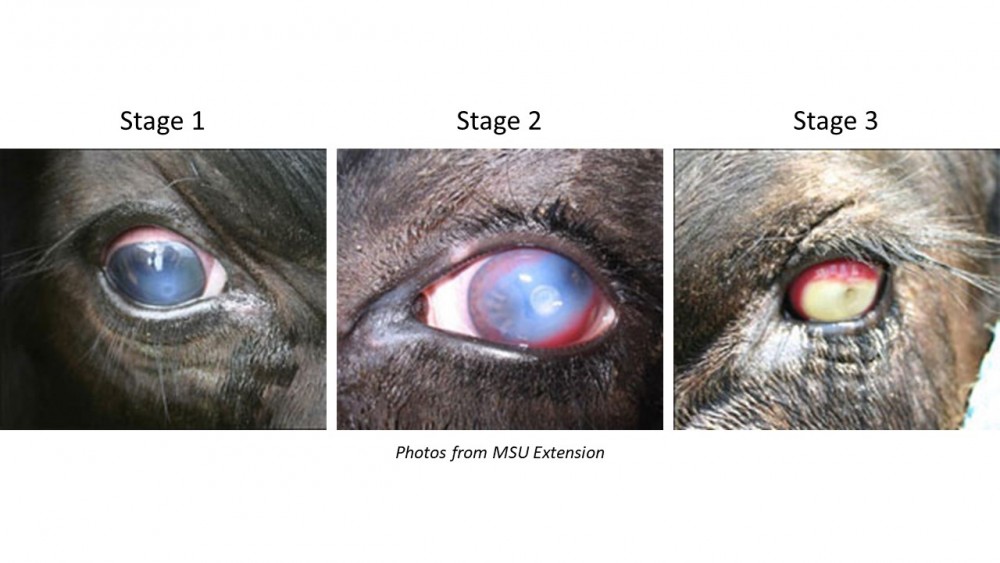Managing Pinkeye in Cattle
Amy Barkley, Livestock Specialist
Southwest New York Dairy, Livestock and Field Crops Program
Managing Pinkeye in Cattle
Pinkeye is a highly contagious disease of cattle which can affect individuals of any age and line. It develops when the causative bacterium, Moraxella bovis, combines with factors that weaken the eye allow the bacteria to enter.
While any animal can be affected, it is more commonly seen in calves, since they have not yet developed protective antibodies on the surface of their eyes to ward off bacteria. Regarding gender, bull calves are more prone to developing this condition than heifer calves. Breeds that are more susceptible are those without eyelid pigment, which include Herefords, Hereford crosses, Charolais, and some Holsteins. This condition has a greater potential to spread when animals are kept in close quarters, but it follows a seasonal pattern where incidences increase in spring, peak in summer, and decrease going into the fall.
The condition has three stages of development. Stage 1 begins with tearing in combination with squinting from sunlight sensitivity in the affected eye. At this point, the eye will begin to appear cloudy from inflammation, and will have an ulcer in the cornea, which appears as a white spot. The second stage of infection is marked by the ulcer spreading across the cornea in conjunction with a pinkish hue to the eye, resulting from blood vessels growing in to promote healing. The third stage is marked by the ulcer covering the entire cornea and the eye turning yellow from the build-up of fibrin (a pus-like substance) as a result of the infection reaching the inner parts of the eye. It is important to manage pinkeye as soon as it is discovered, since not only does it cause discomfort, but it can also reduce production and weight gains if the infection progresses to the point of partial or full blindness.

Summer is typically when producers see a spike in infections, since UV light and face flies are at their peak, irritating eyes and transmitting the bacteria from infected to non-infected individuals. Dust and tall grasses can also be eye irritants and are also part of the summer season.
Of these four irritants, the one that producers have the most control over is face flies. Controlling face flies is most important to limit the spread of the disease. This can be done through pesticide applications and/or an integrated pest management (IPM) program. Rotational grazing can be part of these such programs. Because these flies take 10-21 days to complete their lifecycle, if cattle are moved from pastures before the flies hatch, it can help limit the infestation. Additionally, if a farm has the flexibility in their breeding program, animals which show higher levels of parasite resistance can be selected for.
The best way to treat this disease is through prevention. Unfortunately, vaccines are not very effective if they are not targeted toward the specific strain of bacteria you have on your farm. If pinkeye still shows up in the herd after vaccinating and adopting management practices to limit face flies, using antibiotics is an effective way to treat affected individuals. Keep in mind that an outbreak is considered when 5% -10% of the animals are affected. Treating early will help limit potential production losses. Talk to your veterinarian about treatment options.
For more information on pinkeye management options, contact Livestock and Beginning Farm Specialist, Amy Barkley, at amb544@cornell.edu or (716) 640-0844.
The following articles have been referenced in this write-up, and may be helpful follow-up resources:
Pinkeye in Beef Cattle, Virginia Cooperative Extension
Pinkeye In Cattle, Michigan State University Part 1
Pinkeye In Cattle, Michigan State University Part 2
Pinkeye In Cattle, Michigan State University Part 3
The Easiest Way to Treat Pinkeye, On Pasture
Treatment of Pinkeye in Cattle, Virginia Tech Cooperative Extension
Upcoming Events
2024 Aurora Farm Field Day
August 1, 2024
Aurora, NY
The annual Cornell Field Crop Research Field Day will be Thursday, August 1 at the Musgrave Research Farm, Aurora, N.Y. The program features walking and hay wagon tours in the morning and afternoon.
2024 Broiler Field Day at Laughing Earth Farm
August 19, 2024 : 2024 Broiler Field Day at Laughing Earth Farm
Cropseyville, NY
Join us for a free field day to explore broiler production, processing, and finances. Zack and Annie Metzger will be our hosts. They have run this 200 year-old small diversified farm for 8 years. They process their poultry in a 20C kitchen, where they produce value-added products like sausage and dehydrated chicken feet.
2024 Broiler Field Day at Majestic Farm
August 20, 2024 : 2024 Broiler Field Day at Majestic Farm
Mountaindale, NY
Join us for a free field day to explore broiler production, processing, and finances. Brett and Sara Budde will be our hosts. They raise slow-growth organic broilers on their diversified farm in large flocks on woodland pasture. Their birds are processed into whole birds, parts, and chicken sausage.
Announcements
No announcements at this time.





